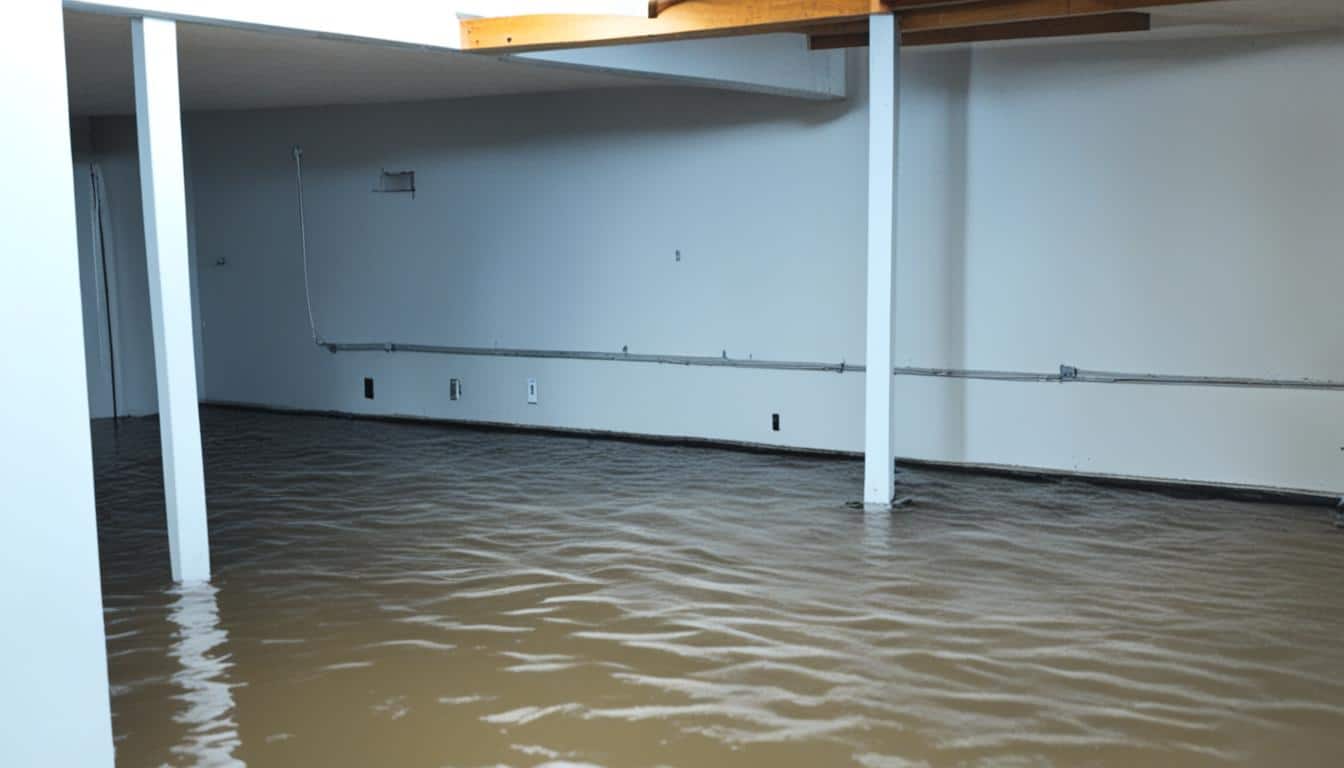In this section, we will discuss the impact of water damage and identify the items that are most vulnerable to being ruined. Understanding what can get damaged is crucial for protecting your home, minimizing costly losses, and preventing potential hazards.
Key Takeaways:
- Water damage can lead to costly losses and potential hazards.
- Furniture and upholstery are susceptible to water damage, causing ruin and irreversible damage.
- Electronics and appliances can be rendered useless and pose electrical hazards when exposed to water.
- Flooring and carpets can suffer warping, mold growth, and structural instability due to water damage.
- Personal belongings and sentimental items are at risk of being ruined by water damage.
Now that we understand the impact of water damage and the items that are most susceptible to ruin, let’s delve into each category to learn how to safeguard them and protect your home.
Furniture and Upholstery
Water damage can have disastrous consequences for your furniture and upholstery. Whether you have wooden furniture or fabric upholstery, prolonged exposure to water can lead to a range of issues, including swelling, warping, discoloration, and even mold growth. The damage caused by water can be irreversible and may require expensive repairs or replacements.
To protect your furniture from water damage, it’s essential to take preventive measures and act promptly if you experience any water-related incidents in your home. Here are some tips to safeguard your furniture and prevent further damage:
- Act quickly: If your furniture gets wet, remove any excess water and dry it as soon as possible. Use absorbent materials, such as towels or dry cloths, to soak up the water.
- Keep it elevated: Place furniture on blocks or elevate it to prevent it from sitting in pooled water or damp areas.
- Clean and dry: Clean your furniture thoroughly and ensure it is completely dry before returning it to its original position. This helps prevent mold and mildew growth.
- Provide ventilation: Ensure good airflow in the room to aid in the drying process. Open windows and use fans or dehumidifiers to enhance air circulation.
- Use protective covers: Invest in waterproof or water-resistant covers for your furniture to provide an extra layer of protection against accidents and spills.
- Address water issues: Fix any water leaks or issues in your home promptly to prevent future incidents of water damage to your furniture. Regular maintenance of plumbing and roofing systems is crucial.
Preventing Fabric Damage
Fabric upholstery is particularly vulnerable to water damage. To safeguard your fabric furniture, take additional precautions:
- Blot, don’t rub: If your fabric upholstery gets wet, avoid rubbing or scrubbing it, as this can push the water further into the fibers. Instead, use a clean, dry cloth to blot the moisture.
- Allow for drying time: Ensure that the upholstery has ample time to dry completely before using the furniture again. Wet upholstery can be a breeding ground for mold and mildew.
- Consider professional cleaning: If the fabric upholstery has suffered significant water damage or contamination, it may be necessary to consult a professional upholstery cleaner to restore and disinfect it properly.
By following these guidelines, you can protect your furniture and reduce the risk of water damage. Remember, prevention is key when it comes to preserving the integrity and lifespan of your valuable pieces.
Electronics and Appliances
Water and electronics don’t mix well. When water damage occurs, it can render your devices useless and pose serious electrical hazards. Understanding the common risks associated with water-damaged electronics and appliances is essential for safeguarding your home and avoiding potential accidents.
Common Risks of Water Damage to Electronics and Appliances
Exposure to water can cause irreversible damage to various electronic devices and appliances, such as:
- Smartphones and tablets
- Laptops and computers
- Television sets
- Home theater systems
- Refrigerators and freezers
- Dishwashers and washing machines
The sequel follows…
Strategies for Protecting Your Electronics and Appliances
To minimize the risk of water damage to your electronics and appliances, consider implementing the following strategies:
- Keep electronics and appliances away from sources of water, such as open windows, sinks, and leak-prone areas.
- Use surge protectors or power conditioners to safeguard against electrical surges resulting from water exposure.
- Ensure proper ventilation and airflow around electronic devices to prevent moisture build-up and condensation.
- Invest in water-resistant or waterproof cases for portable electronics, especially when using them in wet environments.
- Regularly inspect and maintain appliances, checking for any signs of water damage or leaks.
- If water damage occurs, promptly disconnect the affected devices from power sources, and avoid attempting to turn them on until they have thoroughly dried.
comments
| Appliance | Risk of Water Damage | Preventive Measures |
|---|---|---|
| Smartphones and tablets | Prolonged exposure to water can cause malfunctions or complete failure. | Use waterproof cases or keep them away from water sources. |
| Television sets | Water damage can lead to electrical issues, distorted picture quality, or even permanent damage. | Avoid placing drinks or water containers near the TV and have proper ventilation around the device. |
| Refrigerators | Water leaks can damage internal components, affect cooling efficiency, and lead to mold growth. | Regularly inspect for leaks and ensure proper leveling of the refrigerator. Clean and replace gaskets if necessary. |
| Washing machines | Water damage can corrode electrical connections, affect functionality, and lead to mold growth. | Check hoses and fittings for any leaks or damage. Promptly repair or replace faulty components. |
Flooring and Carpets
Flooring materials, such as carpets, hardwood, laminate, and tile, are highly susceptible to water damage. When exposed to excessive moisture, they can suffer from warping, discoloration, mold growth, and structural instability. It’s important to take proactive steps to prevent water damage, as it can be an expensive and time-consuming problem to address.
One of the primary concerns with water damage to flooring is the risk of ruined carpets. Carpets are known for their water absorption properties, making them vulnerable to moisture seepage. When carpets become saturated, they may develop an unpleasant odor and foster mold and mildew growth. Additionally, prolonged exposure to water can weaken the carpet fibers, leading to irreversible damage.
To prevent water damage to your floors and carpets, there are several measures you can take:
- Ensure proper ventilation in areas prone to moisture, such as bathrooms and kitchens.
- Place absorbent mats near entrances to trap any water or dirt before it reaches your carpets.
- Install leak detectors and regularly check for signs of moisture in your home.
- Address any plumbing issues promptly to prevent water leaks or bursts.
- Consider using water-resistant flooring materials, such as vinyl or porcelain tiles, in areas susceptible to water damage.
In the event of water damage, it’s essential to act quickly to minimize the extent of the damage and prevent mold growth. Immediately remove any standing water and thoroughly dry the affected area to prevent further absorption and mold proliferation.
| Flooring Type | Water Damage Risks | Preventive Measures |
|---|---|---|
| Carpets | Ruined fibers, mold growth, discoloration | Regular cleaning, prompt removal of spills, and use of absorbent mats |
| Hardwood | Warping, buckling, mold growth | Proper sealing, prompt cleanup of spills, and humidity control |
| Laminate | Warped boards, swelling, mold growth | Moisture-resistant underlayment, prompt cleanup of spills |
| Tile | Grout damage, tile detachment, mold growth | Regular grout maintenance, proper sealing, prompt cleanup of spills |
Remember, prevention is key when it comes to water damage to your flooring and carpets. By implementing these preventive measures, you can protect your investment and preserve the aesthetic appeal of your home.
Personal Belongings and Sentimental Items
When it comes to water damage, the destruction of personal belongings can be particularly devastating. Items with sentimental value, including cherished photographs, important documents, precious jewelry, and family heirlooms, are at risk of being ruined beyond repair. Losing these irreplaceable items can cause immense heartache and emotional distress.
To protect your precious memories and sentimental possessions, it is crucial to take preventive measures. One effective solution is to invest in water-resistant storage options. These specialized containers or storage units are designed to keep your belongings safe from water damage.
By utilizing water-resistant storage, you can create a barrier between your cherished items and any potential water exposure. Whether it’s airtight containers for photographs and documents or moisture-resistant jewelry boxes, these storage solutions offer added protection and peace of mind.
Additionally, consider storing your sentimental items on higher levels of your home to reduce the risk of water damage. Placing them in elevated areas, away from potential sources of water such as basements or pipes, can provide an extra layer of protection.
Remember, sentimental value cannot be measured by its monetary worth alone. By taking proactive steps to safeguard your personal belongings from water damage, you are preserving precious memories and ensuring that future generations can cherish them as well.
| Types of sentimental items | Water-resistant storage solutions |
|---|---|
| Photographs | Airtight photo storage boxes |
| Documents | Waterproof document bags |
| Jewelry | Moisture-resistant jewelry boxes |
| Heirlooms | Sealed containers or display cases |
Structural Elements and Foundations
Water damage can have devastating effects on the structural integrity of your home. When water infiltrates the structural elements, such as walls, floors, and ceilings, it can lead to compromised foundations, weakened support systems, and mold infestation.
One of the most significant risks of water damage to structures is the potential for compromised foundations. Excessive moisture can penetrate the foundation walls and weaken their stability over time. This can result in uneven settlement, cracks, and even structural collapse if left untreated.
In addition to compromised foundations, water damage can also impact the overall structural integrity of your home. Water-soaked materials, such as wood and drywall, can lose their strength and stability, compromising the safety of your property. Furthermore, prolonged exposure to moisture creates a favorable environment for mold growth, which can further deteriorate the structural elements and pose a risk to your health.
It is crucial to detect and address water damage to your home’s structural elements promptly. Regular inspections can help identify any signs of water intrusion, such as dampness, discoloration, or warping. Promptly addressing these issues can prevent further damage and minimize the risk of more costly repairs in the future.
To mitigate and repair water damage to your home’s structural elements, consider the following steps:
- Identify the source of water intrusion: Whether it’s a leaky roof, faulty plumbing, or poor drainage, identifying and addressing the source of water entry is essential to prevent further damage.
- Remove standing water and dry the affected areas: Use a wet-dry vacuum or professional extraction equipment to remove any standing water. Use dehumidifiers and fans to dry the affected areas thoroughly.
- Address mold infestation: If mold is present, it’s crucial to hire a professional mold remediation service to safely remove it and prevent further spread.
- Repair or replace damaged structural elements: Consult with a professional contractor to assess the extent of the damage and perform necessary repairs or replacements to ensure the structural integrity of your home.
- Implement preventive measures: Taking proactive steps such as improving drainage, waterproofing vulnerable areas, and maintaining gutters can help prevent future water damage to your home’s structural elements.
By addressing water damage promptly and effectively, you can protect the structural integrity of your home, safeguard your loved ones, and preserve the value of your property.
| Effects of Water Damage to Structures | Prevention and Remediation |
|---|---|
| Weakened foundations | Regular inspections of foundation walls and prompt repairs |
| Compromised structural integrity | Dry out affected areas and consult a professional for repairs |
| Mold infestation | Hire a professional mold remediation service to remove mold safely |
Insulation and Wiring
When it comes to water damage, it’s crucial to recognize the potential dangers posed to your home’s insulation and wiring. Protecting these elements is not only essential for maintaining energy efficiency but also for ensuring the safety of your household. Let’s explore the implications of water damage to insulation and wiring.
The Impact on Insulation
Water damage can have a detrimental effect on insulation materials throughout your home. Insulation acts as a barrier to regulate temperature and improve energy efficiency. However, when exposed to water, insulation can become compromised, leading to reduced effectiveness and increased energy consumption.
Moisture in insulation can lead to mold growth, compromising indoor air quality and potentially causing health issues. It also weakens the insulation’s structure, reducing its ability to trap heat or cold and maintain a comfortable environment inside your home.
Protecting Your Wiring
Water damage can also pose significant risks to your electrical wiring. When water penetrates the wiring system, it can lead to short circuits, electrical shocks, and even electrical fires. Damaged wiring not only affects the functionality of electrical appliances and fixtures but also jeopardizes the safety of your household.
To mitigate these risks, it’s crucial to promptly address any signs of water damage near electrical outlets, fuse boxes, or exposed wiring. Taking preventive measures, such as keeping wires elevated, installing ground fault circuit interrupters (GFCIs), and ensuring proper insulation, can help safeguard your home from electrical hazards.
Ensuring Safety and Efficiency
By protecting your home’s insulation and wiring from water damage, you can ensure both the energy efficiency and safety of your property. Regular inspection, maintenance, and timely repairs are key to minimizing the risks associated with water damage. Additionally, addressing water intrusion issues, such as roof leaks or plumbing leaks, promptly can help prevent further damage to these vital components of your home.
Remember, the consequences of water damage to insulation and damaged wiring extend beyond immediate repairs. They can have long-term implications for your household’s energy consumption, indoor comfort, and safety. Prioritizing preventive measures and taking immediate action when water damage occurs will help maintain the integrity of your insulation and wiring, providing peace of mind for you and your family.
Conclusion
Understanding the impact of water damage and the items that are most vulnerable to destruction is essential for safeguarding your home and belongings. By implementing preventive measures and promptly addressing water damage, you can minimize costly losses, prevent potential hazards, and maintain the long-term integrity of your property.
Take action now to protect against the devastating effects of water damage. Ensure that your furniture and upholstery are shielded from prolonged exposure to water, preventing swelling, warping, and mold growth. Safeguard your electronics and appliances to avoid rendering them useless and reduce the risk of electrical hazards.
Additionally, pay attention to your flooring and carpets, which are highly susceptible to water damage. Prevent warping, discoloration, and mold growth by taking appropriate precautions. Safeguard your personal belongings and sentimental items by storing them in water-resistant containers, preserving cherished memories for years to come.
Furthermore, be proactive in detecting and mitigating water damage to your home’s structural elements and foundations. Weak foundations and compromised structural integrity can lead to serious safety risks. Protect insulation and wiring to maintain energy efficiency, reducing the risk of electrical fires and potential health hazards.
By understanding the implications of water damage and following the recommended preventive strategies, you can ensure the long-term stability and safety of your property. Don’t wait for water damage to occur; take action now to protect what matters most.
FAQ
What are the items most vulnerable to water damage?
Items that are most vulnerable to water damage include furniture, upholstery, electronics, appliances, flooring, carpets, personal belongings, sentimental items, structural elements, foundations, insulation, and wiring.
How does water damage impact furniture and upholstery?
Water damage can cause swelling, warping, discoloration, and mold growth in wooden furniture, as well as ruin fabric upholstery.
What are the risks associated with water damage to electronics and appliances?
Water damage can render devices useless and pose electrical hazards. It is important to protect electronics and appliances from water exposure to prevent accidents.
What are the effects of water damage on flooring and carpets?
Excessive moisture can lead to warping, discoloration, mold growth, and structural instability in flooring materials like carpets, hardwood, laminate, and tile.
How does water damage impact personal belongings and sentimental items?
Water damage can destroy personal belongings, such as photographs, documents, jewelry, and heirlooms. It is crucial to protect these items and consider water-resistant storage solutions.
What are the potential risks of water damage to structural elements and foundations?
Water damage can weaken foundations, compromise structural integrity, and lead to mold infestation. Detecting, mitigating, and repairing water damage is essential for the stability and safety of your property.
How does water damage affect insulation and wiring?
Water damage can reduce the energy efficiency of insulation and damage electrical wiring, increasing the risk of electrical fires. Protecting insulation and wiring from water damage is important for maintaining a safe and efficient home.
What are the key takeaways from understanding water damage impact?
By understanding what can get ruined in water damage, you can protect your home and belongings, minimize losses, prevent hazards, and ensure the long-term integrity of your property.






